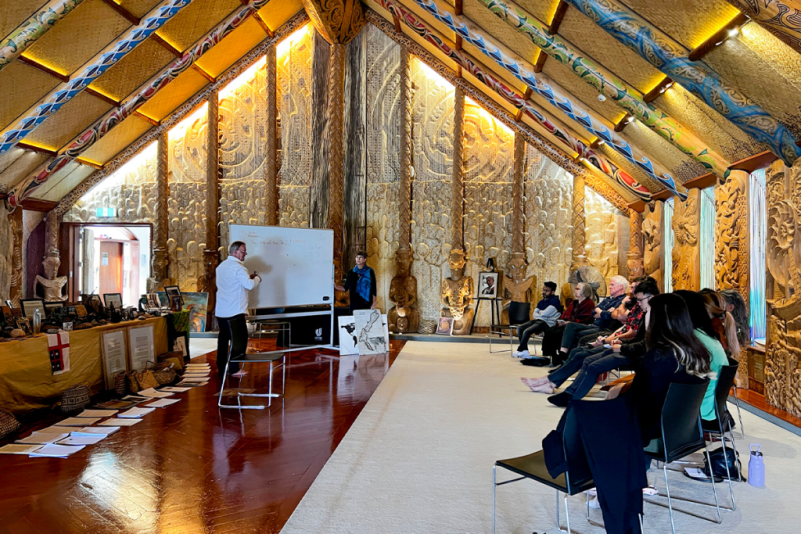Imagine a construction sector guided not only by technology but knowledge uniquely connected to the rich heritage of Aotearoa.
This is the hopes of the Ngākopa Construction 4.0 kairangahau (researchers) who are drawing from mātauranga Māori as a blueprint for building with purpose, resilience and respect for both people and place.
What is mātauranga Māori?
At HERA, we use a definition developed by Kahui Legal to understand mātauranga Māori:
Mātauranga Māori (often translated as Māori knowledge) is a dynamic and evolving system of customary and contemporary knowledge used by tangata whenua (people of this land by right of first discovery) to interpret and explain the world in which they live. It Mātauranga Māori is framed by the whakapapa (genealogy) of all things and whanaungatanga (kinship connections) between them.
Mātauranga Māori includes general knowledge as well as specific knowledge held by or relevant to whānau, hapū, or iwi. Mātauranga Māori is transmitted in a variety of forms, including:
- oral histories and whakapapa (geneaology);
- waiata (songs), karakia (prayers and incantations), and haka (cultural dance);
- whakataukī (proverbs or sayings), pūrākau (legend, myth, story), and korero tuku iho (history, stories of the past, traditions); and
- raranga (waving), whakairo (carving), and ta moko (traditional tattooing).
Examples of mātauranga Māori include (but is not limited to) kawa (customary protocols) and tikanga (Māori traditions, values, and concepts. It encompasses Māori philosophies, world views, and unique perspectives, creating.a rich and comprehensive understanding of life and connection to whenua (land).
The WAI262 claim also provides valuable insights into the depth and significane of mātauranga Māori, highlighting its role and relevance in today’s world.
How does this relate to Construction 4.0?
Our $10.3 Endeavour funded Construction 4.0 research project includes an underpinning mātauranga Māori theme led by A/Prof Fleur Palmer from AUT. Fleur and her team are developing practical guidance to help sectoral participants incorporate mātauranga Māori in their practises.
In this project, Prof Jeroen van der Heijden proposed a broader definition of Construction 4.0, which highlights its role not only in technical transformation, but from a broader social, economic and environmental aspect. This expanded view of Construction 4.0 underscores the importance of cultural engagement and
positions Mātauranga Māori as an essential component of achieving a more holistic and meaningful approach within the sector – and there is much more the sector can do to engage meaningfully in this mahi (work).
“It is relevant to note Construction 4.0 can be understood in a narrow and a broad sense. In a narrow sense, Construction 4.0 refers to the integration of digital technologies, data analytics, and automation of the construction process to improve the efficiency and productivity of the construction process [2,5]. This includes technologies such as Building Information Modelling (BIM), Internet of Things (IoT), robotics and automation, prefabrication and off-site construction, and Virtual Reality (VR) and Augmented Reality(AR). Under this narrow understanding, Construction 4.0 is seen primarily as a technological shift that promises to deliver significant improvements in cost, time, and quality performance in construction projects [6].
The broader understanding of Construction 4.0 encompasses social, economic, and environmental aspects [7]. It recognizes that adopting digital technologies and automation must be accompanied by changes in organizational, legal, and cultural structures within the construction industry to fully realize its potential [8]. Moreover, it acknowledges the impact of these technologies on the wider built environment and the importance of ensuring long-term sustainability and resilience [9]. Finally, it emphasizes the need for a holistic approach, understanding that digital technology alone cannot address these challenges [10]. In summary, the broader perspective examines the implications of Construction 4.0 on society, the environment, governance, and technology itself (further referred to as the ‘SEGT dimensions’).”
The creation of the concept of Ngākopa Construction 4.0 by Saul Roberts reflects the synergy between mātauranga Māori and Construction 4.0. It places Construction 4.0, within its broader sense, in a uniquely Aotearoa New Zealand context. This paves the way for a construction sector that is not only innovative but deeply connected to the values and knowledge of the land.
What to explore this more?
If you’re interested in practical tools to embed mātauranga Māori more into your workplace approaches, you might also consider reaching out to our GM Comm 4.0, Kim Nugent, who is developing a Mātauranga Māori Toolbox to support businesses and individuals in this space at kim.nugent@hera.org.nz.


